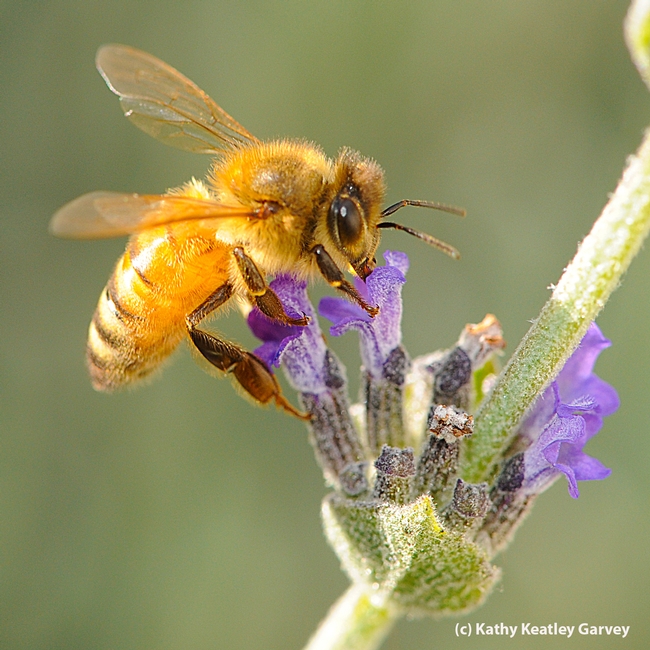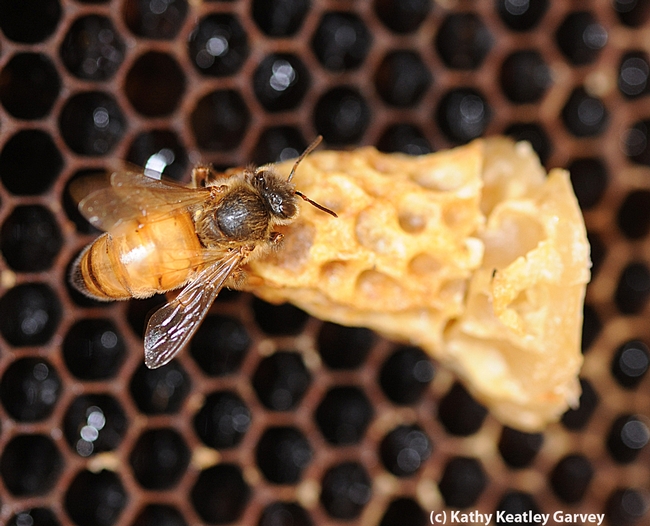It's Christmas Day and time to revisit "The 13 Bugs of Christmas."
Back in 2010, Extension apiculturist Eric Mussen of the UC Davis Department of Entomology and yours truly came up with a song about "The 13 Bugs of Christmas." Presented at the Department of Entomology's holiday party, it drew roaring applause. Then U.S. News featured it when reporter Paul Bedard picked it up.
It's still making the rounds, via tweets.
"The 13 Bugs of Christmas" is about a psyllid in a pear tree, six lice a'laying, 10 locusts leaping and 11 queen bees piping. Beekeepers know that distinctive sound of a queen bee piping.
"We attempted to keep the wording as close as possible for ‘The 12 Bugs of Christmas' and then we opted to spotlight some new agricultural pests in the next stanza," said Mussen, an Extension apiculturist and member of the UC Davis Department of Entomology faculty since 1976.
The song:
On the first day of Christmas, my true love gave to me, a psyllid in a pear tree.
On the second day of Christmas, my true love gave to me, two tortoises beetles and a psyllid in a pear tree
On the third day of Christmas, my true love gave to me, three French flies, two tortoise beetles and a psyllid in a pear tree
On the fourth day of Christmas, my true love gave to me, four calling cicadas, three French flies, two tortoise beetles and a psyllid in a pear tree
On the fifth day of Christmas, my true love gave to me five golden bees, four calling cicadas, three French flies, two tortoise beetles and a psyllid in a pear tree
On the sixth day of Christmas, my true love gave to me six lice a'laying, five golden bees, four calling cicadas, three French flies, two tortoise beetles and a psyllid in a pear tree
On the seventh day of Christmas, my true love gave to me seven boatmen swimming, six lice a'laying, five golden bees, four calling cicadas, three French flies, two tortoise beetles and a psyllid in a pear tree
On the eighth day of Christmas, my true love gave to me eight ants a'milking, seven boatmen swimming, six lice a'laying, five golden bees, four calling cicadas, three French flies, two tortoise beetles and a psyllid in a pear tree
On the ninth day of Christmas, my true love gave to me nine mayflies dancing, eight ants a'milking, seven boatmen swimming, six lice a'laying, five golden bees, four calling cicadas, three French flies, two tortoise beetles and a psyllid in a pear tree
On the tenth day of Christmas, my true love gave to me 10 locusts leaping, nine mayflies dancing, eight ants a'milking, seven boatmen swimming, six lice a'laying, five golden bees, four calling cicadas, three French flies, two tortoise beetles and a psyllid in a pear tree
On the 11th day of Christmas, my true love gave to me 11 queen bees piping, 10 locusts leaping, nine mayflies dancing, eight ants a'milking, seven boatmen swimming, six lice a'laying, five golden bees, four calling cicadas, three French flies, two tortoise beetles and a psyllid in a pear tree
On the 12th day of Christmas, my true love gave to me 12 deathwatch beetles drumming, 11 queen bees piping, 10 locusts leaping, nine mayflies dancing, eight ants a'milking, seven boatmen swimming, six lice a'laying, five golden bees, four calling cicadas, three French flies, two tortoise beetles and a psyllid in a pear tree
Knowing the agony that Californians experience with the seemingly unending flood of pests, Mussen felt it "bugworthy" to add this verse:
"On the 13th day of Christmas, Californians woke to see:
13 Kaphra beetles
12 Diaprepes weevils
11 citrus psyllids
10 Tropilaelaps clareae
nine melon fruitflies
eight Aedes aegypti
seven ash tree borers
six spotted-wing Drosophila
five gypsy moths
four Japanese beetles
three imported fire ants
two brown apple moths
and a medfly in a pear tree"
Mussen, who led the department in song at the 2010 holiday party (he also sings "doo-wopp" with a local chorus), noted that "Tropilaelaps clareae" is a honey bee mite from Asia.
Another Asian mite, the Varroa mite, (Varroa destructor), was first identified here in the United States (Wisconsin) in 1987 and is now the beekeepers' No. 1 problem, said Mussen, who writes the bimonthly from the UC apiaries newsletter.
Tropilaelaps clareae is indeed something to worry about.
Attached Images:

